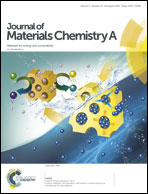Bridging Mo2C–C and highly dispersed copper by incorporating N-functional groups to greatly enhance the catalytic activity and durability for carbon dioxide hydrogenation†
Abstract
In this work, we report a facile and controllable method to enhance the catalytic activity and stability of Mo2C–C for CO2 hydrogenation by incorporating N-functional groups on the interface of Mo2C–C to simultaneously serve as basic sites for improving CO2 chemisorption and to immobilize copper particles to prevent aggregation. The incorporated N changed the surface chemical environment of Mo2C and Cu, resulting in the coexistence of Cu2+/Cu+/Cu0 and electron transfer from the copper to the molybdenum species (via MoOxCy–□–Cu+/Cu0). The strong coupling effects of N, Mo2C, and Cu on Cu–Mo2C–N–C is beneficial for further enhancing the adsorption and activation of CO2 and H2 molecules. Accordingly, the Cu–Mo2C–N–C catalysts exhibit greatly superior catalytic activity and stability toward CO2 hydrogenation compared with other catalysts. This facile method may be extended to other materials-based interface engineering to fabricate efficient CO2 hydrogenation catalysts.



 Please wait while we load your content...
Please wait while we load your content...